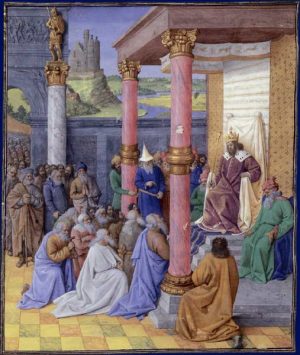In the Bible, Cyrus the Great was introduced as the King of Persia. He was mentioned over 23 times in the Old Testament, specifically in the Books of Isaiah, Ezra, Daniel, and the Chronicles. Other names used to refer to him were “Cyrus II” and “Cyrus the Elder.”
Despite being a pagan ruler, the Hebrew Bible credits him with taking control of Babylon using the Persian army and freeing the Jews who were held captive there for 70 years due to the Jewish–Babylonian War.
The Prophecy of Isaiah
In the book of Isaiah, the prophet mentioned Cyrus 150 years before he was born, describing him as the “anointed” one or Messiah, who will be raised for “He will rebuild (God’s) city and set (God’s) exiles free, but not for a price or reward” (Isaiah 45:13).
The liberator was characterized as a pagan in the lines “bestow on you a title of honor, though you do not acknowledge me” (Isaiah 45:4), a reference to Cyrus the Great who, despite not knowing the Jewish God, allowed the Jews to be freed from Babylonian captivity, even providing them with assistance in rebuilding God’s temple.
The Book of Ezra
In the book of Ezra, it is written that Cyrus proceeded to help the Jews return home and rebuild their temple. As Ezra 1:2 states:
‘”This is what Cyrus, king of Persia, says:
“‘The Lord, the God of heaven, has given me all the kingdoms of the earth, and he has appointed me to build a temple for him at Jerusalem in Judah.”‘
The chapter continues to describe how Cyrus gave the released peoples in Babylonia resources such as “silver and gold, with goods and livestock” and “offerings” for God’s temple in Jerusalem (Ezra 1:4). Cyrus’ support for building a temple was also mentioned in chapter 6 as follows:
“In the first year of King Cyrus, the king issued a decree concerning the temple of God in Jerusalem:
Let the temple be rebuilt as a place to present sacrifices, and let its foundations be laid… The costs are to be paid by the royal treasury.” (Ezra 6:3-4)
The Book of Daniel
In the Book of the prophet Daniel also discussed Cyrus’ reign. Daniel had been captured by King Nebuchadnezzar of Babylonia and continued to be in service of Babylonian nobility until Cyrus’ third year.
Flavius Josephus in Antiquities of the Jews goes so far as to say that Daniel most likely showed Cyrus the scrolls of the Old Testament that talk about him. The prophet is said to have “prospered during the reign of Darius and the reign of Cyrus the Persian” (Daniel 6:28).
Cyrus Cylinder
To free the Jews, Cyrus issued a decree that released the group in his first year (Chronicles 36:22-23). Archaeological evidence of this event was discovered by a British Museum expedition in 1879: the Cyrus Cylinder.
The artifact is a barrel-shaped piece of clay covered in cuneiform inscriptions that reveal how Cyrus ruled over Babylonia. This was a custom of Mesopotamian leaders who marked the start of their reign by announcing their reforms. The cylinder recorded that after defeating the last Babylonian king, Nabonidus, the Persian ruler allowed exiled individuals to return to their homelands and restored places of worship, including temples.
In contrast to the findings on the Cyrus Cylinder, the retired Professor Lester L. Grabbe, who specialized in the Hebrew Bible and Early Judaism, argues against the existence of a decree but that there could have been a policy that allowed exiled peoples to return to their homelands over a long period.
